
by Sam Franklin | October 06, 2022 | 23 min read
The comprehensive guide to eCommerce warehouse management
Get fundedLast updated: October 07, 2022
eCommerce is a huge business that just keeps getting bigger. According to reports from Research and Markets, global eCommerce sales are expected to reach $6.07 trillion by 2024.
Running an eCommerce business involves specific practices totally different from regular brick-and-mortar businesses. One essential practice is regarding where to store eCommerce stock and how to manage it effectively. Most eCommerce business owners will choose to hold their stock in their own homes or in a storage facility as they start out. However, there will come a point in time when they need to upgrade and expand. But where do you go once you’ve outgrown your own space? This is where eCommerce warehousing comes into play. eCommerce warehousing makes it easier for you to manage and store all of your inventory. If done correctly, eCommerce warehouse management helps to keep products organised and saves time and costs in product sourcing and shipping. This article will cover everything you need to know about eCommerce warehouse management and will detail all the different systems involved.
Table of contents
- What is eCommerce warehousing?
- What is an eCommerce warehouse management system?
- Why should you use an eCommerce warehouse management system?
- How to choose the ideal warehouse management system for your eCommerce business?
- eCommerce platforms vs eCommerce warehouse management systems: What’s the difference?
- Top eight warehouse management software solutions in 2022
- Conclusion
What is eCommerce warehousing?

eCommerce warehousing is everything that involves the storage and management of the products that you are selling online. It is also commonly referred to as a fulfilment centre warehouse or distribution centre.
In addition to the storage space, eCommerce warehouses will typically have their own warehouse management system (WMS) to handle all the processes involved in running the eCommerce warehouse. This covers inbound and outbound operations, including when stock arrives at the warehouse, how it is stored and tracked, picking and packing, and shipping.
Some eCommerce businesses might choose to use traditional warehouses for their storage and utilise traditional warehouse management solutions to organise their operations. However, for the most part, these systems are not built to handle specific demands required in eCommerce.
For example, traditional warehouse solutions are not usually suited for the type and quantity of orders received and aren’t prepared for big fluctuations in demand. As a result, eCommerce businesses are better suited to using specific eCommerce warehouse solutions to store their goods and warehouse management systems to handle organisation.
What does eCommerce warehousing involve?

The eCommerce warehouse provider will typically take care of all the business operations regarding your inventory, including:
Managing all employees that are working at the warehouse.
Managing the safety and security of the warehouse and employees.
Sorting and storing inventory within the warehouse.
Keeping track of all equipment and inventory - including raw materials and finished goods.
Monitoring each part of the logistics process from the moment stock arrives to when it is shipped.
Shipping products for order fulfilment.
Forecasting customer demand to manage overstocking or out-of-stock issues.
Providing detailed reporting and insights for your entire inventory.
Different types of eCommerce warehouses
eCommerce warehouses come in all different shapes and sizes. It is essential to ensure that the warehouse setup is ideally suited to your eCommerce requirements to ensure the entire operation runs efficiently.
The following are some of the most common types of eCommerce warehouses.
Private warehouses
Private warehouses are typically owned by larger businesses. They are more expensive to purchase or rent than others as they are built to suit specific needs.
It is a worthwhile investment over the long-term but is ideally suited to eCommerce SMBs, private distributors, or wholesalers.
Public warehouses
Public warehouses are typically owned by government agencies. They are then rented out to public businesses.
These are much more affordable but offer reduced functionality as they offer no specialised services. As a result, they are a great option for short-term requirements but often don’t provide enough efficiency for the long term.
Cooperative warehouses
Cooperative warehouses are jointly owned by several businesses involved in the same sector and require similar storage needs.
It's a joint private warehouse with more than one owner, and all the fees are usually split amongst the owners. They can sometimes be rented to outside businesses, but this is rare.
Smart warehouses
Smart warehouses use advanced technology such as AI and warehouse automation to help with storage and management.
Automation in smart warehouses isn’t limited to software as they use lots of AI and robots to automate the logistics inside the warehouse. The warehouses offer excellent efficiency and productivity but can also be very costly for small eCommerce businesses.
Amazon fulfilment centres are great examples of smart warehouses.
Choosing the right type of warehouse is an important decision. Take a look at our eCommerce Warehousing Basics article to learn more about the warehousing side of eCommerce.
Why do most eCommerce businesses choose 3PL as their favourite solution?

Buying or renting an entire warehouse is completely out of the question for most eCommerce brands. Instead, most will decide to outsource the entire customer fulfilment process and supply chain management to a third-party logistics (3PL) provider that owns fulfilment centres in multiple locations.
Typically, these third-party logistics (3PL) providers have regional warehousing optimisation as they own multiple warehouses. This gives eCommerce business owners the option to store inventory in multiple fulfilment centres to reach a wider customer base faster.
3PL providers also help eCommerce businesses to save time as most of the time-consuming logistical tasks are handled by the outsourced company. The 3PL providers also have advanced insights about your inventory management processes and can provide detailed reporting to help you understand your business better.
Lastly, 3PL providers are always clued up about any regulatory changes as they are experts in logistics.
Take a look at this article to find your nearest 3PL provider.
What is an eCommerce warehouse management system?

Productive warehouses cost less to run and result in higher revenues for the eCommerce businesses that use them. To improve eCommerce warehouse efficiency and productivity, many integrate powerful warehouse management systems to manage and control warehouse operations.
A warehouse management system (WMS) is a type of software that monitors and controls all the daily operations inside an eCommerce warehouse.
It helps to manage operations such as:
Inventory management and tracking
Order management systems
Task management
Warehouse managers and optimisation design
Picking and packing goods
Shipping logistics
Labour management
Overall, the software helps to streamline the entire process for stock in the warehouse. It ensures that the stock is received, stored, picked, packed, shipped, and replenished. Warehouse management software also helps to manage returns efficiently by helping to determine which items are damaged or are ready to go back on the shelf.
The WMS helps with supply chain visibility by pushing the exact inventory information to your front end, ensuring that your goods are in stock before customers purchase. It also helps to share information with customers, helping them understand their shipment times.
Different types of warehouse management systems and features
Not all warehouse management systems are the same. There are two main categories of WMS available: a standalone WMS and an Integrated with Enterprise Resource Planning (ERP) WMS.
Standalone warehouse management systems
A standalone warehouse management system is highly specialised. The focus in these systems is on warehouse management features that help to track inventory levels and supply chain management.
It provides a wide range of advanced warehouse and inventory management features, such as warehouse picking options, cycle counting, and advanced reporting.
The great thing about standalone warehouse management systems is that they can often be integrated with other systems used in eCommerce. This means you can integrate it into your point of sale, inventory management software, or fulfilment software.
However, standalone systems, unfortunately, lack real-time integration. The warehouse team is usually isolated from the rest of the company and won’t have access to your eCommerce in-house systems, preventing them from updating inventory in real-time. As a result, the warehouse team can be hours or days behind your other systems.
It can also become quite costly to purchase, integrate, and maintain multiple systems to get the core functionality required for your eCommerce business. Furthermore, a standalone WMS typically lacks features, such as warehouse integration and real-time updates, that an integrated WMS provides as standard.
Integrated warehouse management systems
An integrated WMS helps improve eCommerce logistics by combining the WMS with your other tools, such as Enterprise Resource Planning (ERP) software. Typically, ERP software is used to manage your companies resources and gives a full view of all your business operations, such as:
Software applications
Human resources
Sales and marketing operations
Finance and accounting
Inventory tracking
Customer Relationship Management (CRM)
An integrated WMS is usually more costly, but it helps your eCommerce business become much more efficient by replacing all existing software with one interface.
Why should you use an eCommerce warehouse management system?

The benefits of using an eCommerce warehouse management system can greatly increase the efficiency and productivity of your overall eCommerce business.
The following are a few benefits of using a WMS:
More accurate inventory counts and optimisation
Managing inventory is often one of the most complicated procedures in eCommerce operations. For example, if you have too much stock that is perishable - it could easily pass its sell-by date. On the other hand, if you have too little stock, customers are turned away and will often never return.
A WMS can help you know exactly how much inventory is stored in real-time, helping to avoid inventory shrinkage, which costs businesses almost $62 billion annually. It helps to track and monitor the movement of goods along the entire supply chain. A top-tier inventory management solution will include barcode scanners and integrate Radio Frequency Identification Devices (RFID) to ensure the inventory count is up-to-date and easy to find.
Faster order fulfilment
Having a WMS also helps to fulfil orders faster. With the competition from Amazon providing next-day delivery, it is essential to keep pace with the eCommerce giants and remain competitive. A WMS will help your team pick and pack orders more efficiently, meaning your customers' orders will be on the way faster.
Better order efficiency and error elimination
Using a warehouse management system will mean your items will always be correctly listed, so you will never have to worry about customers placing orders for out-of-stock items.
Barcoded inventory and RFID help reduce time spent on admin and the risk of error. The barcode scanners and RFID simply allow staff members to scan product barcodes when packing and shipping orders. If they accidentally scan the wrong barcode, the system will instantly alert them that the wrong product has been scanned, which helps to eliminate errors and also helps to reduce the number of disgruntled customers.
Reduced processing costs
The upfront cost of a WMS might be pricey. However, the benefits of the WMS, including efficient supply chain management, make up for this cost. As an eCommerce owner, you are maximising profits by reducing the time required to process an order.
You can easily work out your processing cost per order with the following formula:
Processing Cost Per Order = Cost of Operations/Number of Orders
Informed data-driven decisions
Having data about your product inventory processes lets you make better business decisions. For example, a WMS can help you quickly identify any high-risk items that see recurring returns and will organise your logistical operations to help reduce them. In addition, the WMS also provides in-depth data about the warehouse staff and lets you know what they spend the most time on.
How to choose the ideal warehouse management system for your eCommerce business?

Different businesses have different needs, so it is essential to ensure the warehouse management software has all the functions needed for your particular operation. If you use the wrong warehouse management solutions, you might have to spend lots of money to replace the system down the line.
Here are a few things to consider when choosing a WMS for your eCommerce business.
Accuracy of information
One of the most important features of your warehouse management system is that it needs to be accurate from the beginning to ensure you run into minimal problems as your business starts to scale.
You need to be certain that the WMS records your inventory transactions properly with as little room for error as possible, as one single error in your inventory could cause a giant cascade of problems, such as a backlog of orders, delayed shipments, and orders that might need to be cancelled.
Training
The system needs to be user-friendly and easy to navigate for staff. If the WMS requires extensive training, it might eat into profits through additional staff training. Additionally, complicated WMS won’t be ideal for temporary staff members.
It’s best to ensure that the WMS has an excellent training program to ensure the warehouse staff have the required skills to maintain the software.
Scalability
It’s essential that the system can grow alongside your business. Choosing the right WMS can help you improve your business from the backend and help you scale as you get more customers.
Data
How a warehouse management system stores and utilises data is also an important factor. Typically, eCommerce businesses run into one of the two following problems: they either have no data to analyse or have too much data that they don’t know what to do with.
A top-tier warehouse management software will gather data from your clients and process it in a way to help you make operational decisions that will aid your business growth.
The WMS should be able to analyse data and identify trends that your eCommerce store could potentially capitalise on. It should provide regular reports to show which parts of your business are growing and the types of products you can cut that aren’t selling as well.
On-site vs Cloud-based
One important feature is whether you want your WMS to be hosted on-site or a cloud-based ERP solution.
Choosing an on-site WMS would require lots of maintenance, and you will likely need to hire experienced staff to make sure everything runs smoothly. In contrast, cloud-based solutions typically don’t incur labour costs or require in-house development teams to keep them running.
A WMS cloud-based solution would generally cost much less than an on-site WMS.
Integration
Finally, you must ensure that the WMS you choose can actually be integrated into all the backend systems you already have running.
eCommerce platforms vs eCommerce warehouse management systems: What’s the difference?

eCommerce platforms and eCommerce warehouse management systems are two totally separate systems.
You can think of the eCommerce platform as the frontend customer-facing platform that handles all the selling and marketing of your products and services. This can include the website customers use to make purchases or any marketing materials used to attract sales. Shopify is a great example of an eCommerce platform.
On the other side, an eCommerce management system simply deals with inventory management and fulfilment. You can consider it as the backend side of your business, and it tracks where your goods are physically kept and how they are shipped to customers.
Once a customer places an order on the frontend store (e.g. Shopify), the order goes to the eCommerce warehouse management system to be fulfilled. The software helps to track, pick, and pack the product.
Top eight warehouse management software solutions in 2022
Choosing the right warehouse management software solution for your eCommerce warehouse can be a make or break for your business. Obviously, you don’t want a solution that is too expensive and filled with features you will never use. On the other hand, you don’t want to choose an inexpensive solution just for the sake of it because it might not be able to scale well alongside your eCommerce business.
Instead, it’s best to first line up all your ducks and make sure you know each feature you might need to use and any additional features that might be required down the line before choosing a WMS to settle on.
Here are eight of the best warehouse management software solutions for 2022 and their best features.
1. ShipBob
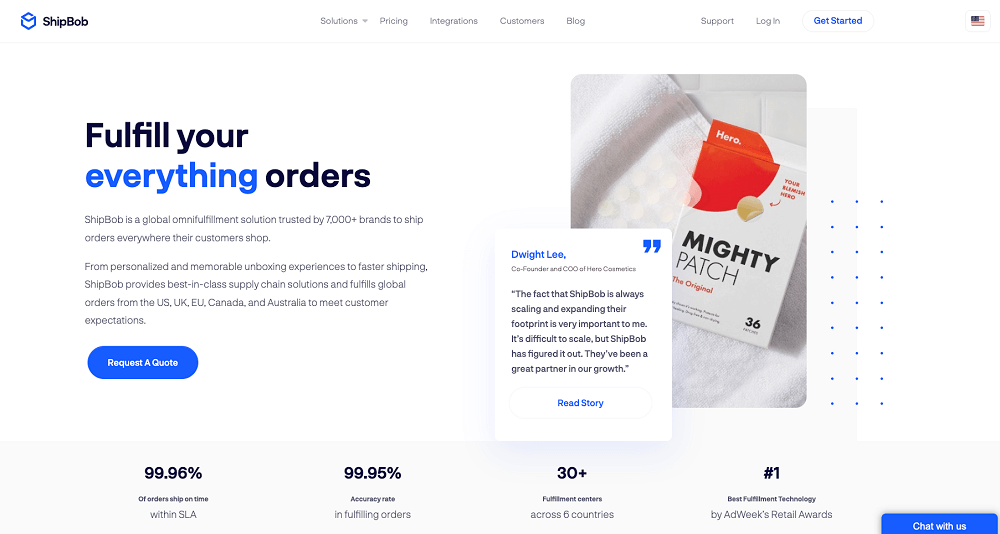
ShipBob describes itself as a global “Omni fulfilment solution” that allows users to ship orders globally to their customers. Based in Chicago, the platform provides a supply chain solution for eCommerce businesses and fulfils global orders from the US, UK, EU, Canada, and Australia. Their homepage states that they have over 7,000 brands that are using the software on a daily basis to fulfil orders. Some of the notable brands include Spikeball, Dossier, and Muddy Bites.
The platform is a tech-enabled 3PL provider with over 30 fulfilment centres in six different countries. Orders get automatically sent to their warehouses, and inventory is picked, packed, and shipped directly to the customers. One of their great features is the ability to distribute your inventory across their multiple fulfilment centres, enabling faster shipping times.
eCommerce store owners simply have to connect their store to their software and send their products. ShipBob will store the inventory and then send the products when customers place their orders.
ShipBob easily connects to platforms such as Shopify, Amazon, BigCommerce, and WooCommerce. They offer a two-day express service for all US orders, allowing eCommerce brands to stay competitive with Amazon shipping.
ShipBob boasts features such as:
3PL management
Air Shipping
Kitting
Inventory management
Recurring orders
RFID and barcodes
They offer a simple, transparent pricing model that allows you to estimate your entire cost from their homepage. The software solution is mainly used for direct-to-customer and business-to-business orders.
2. ShipHero
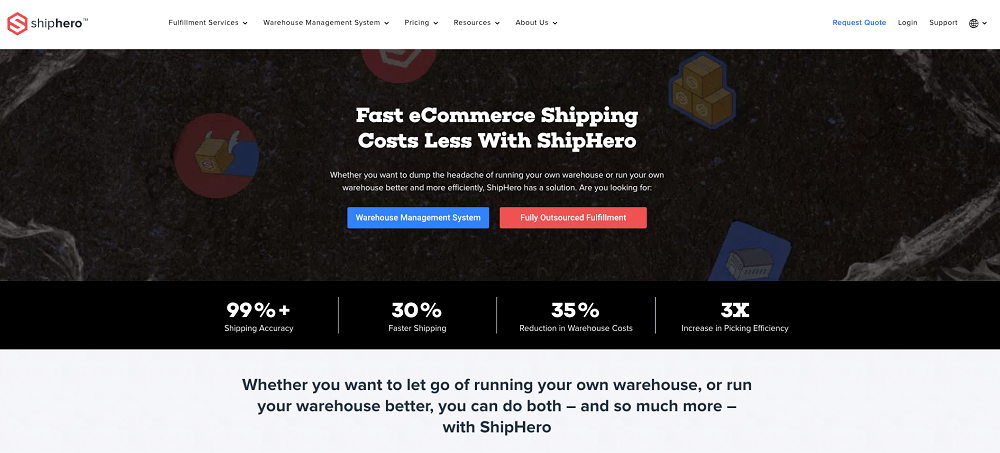
ShipHero is a hybrid eCommerce warehouse management system that helps you organise your own warehouse or use its fulfilment centres to ship your products to your customers. The platform offers one-click integrations to most eCommerce platform backends, meaning you can easily integrate this software into your system.
The platform offers an industry-leading WMS that streamlines your warehouse’s processes to increase efficiency and make your team more productive. Additionally, you can use their outsourced fulfilment centres to ship your products to customers. These fulfilment centres can offer an average delivery speed of 3.5 days, which is much quicker than most 3PLs.
In total, they own and operate seven different warehouses under their umbrella, located in North America and Canada, that boast top-tier features such as:
Inventory management
Supply chain visibility
In-depth reporting
PostHero integrations
eCommerce store owners simply have to connect their backend to the platform with the one-click integration and send over their products. ShipHero will handle the storage, picking and packing, and delivery to your customers.
They offer a flat rate, no zone pricing model, which includes picking, packing, shopping, mailing supplies and postage for their fulfilment service. Their WMS starts at $1,850 per month for eCommerce brands.
3. ShippingEasy

ShippingEasy is a WMS system that helps you print labels, manage orders, automate shopping, and track shipping in one easy-to-use modern user interface. It is a United States cloud-based warehouse management system that offers the most discounted USPS and IPS rates available.
The platform offers seamless integration into popular eCommerce platforms such as eBay, Etsy, Amazon, Shopify, and BigCommerce. ShippingEasy has done everything it can to make the entire warehouse process and supply chain as straightforward as possible by automating as many processes as possible.
Alongside the automated label printing, ShippingEasy also offers a great customer marketing tool to help send promotional material to your customers to keep them coming back. The main features of the platform include:
Label printing
Discounted shipping rates
Advanced analytical reporting
Tracking and returns
Customer marketing tools
In addition to these features, they also offer a Shopify seller package that helps to increase sales by $2,399 on average. The Shopify tool helps to send out promotional emails to customers, contact them to remind them about abandoned carts, and automate the Shopify shipping process.
ShippingEasy offers a free 30-day trial with no credit card required. They offer a range of packages that start from $29 per month and reach as high as $159 per month.
4. Veeqo
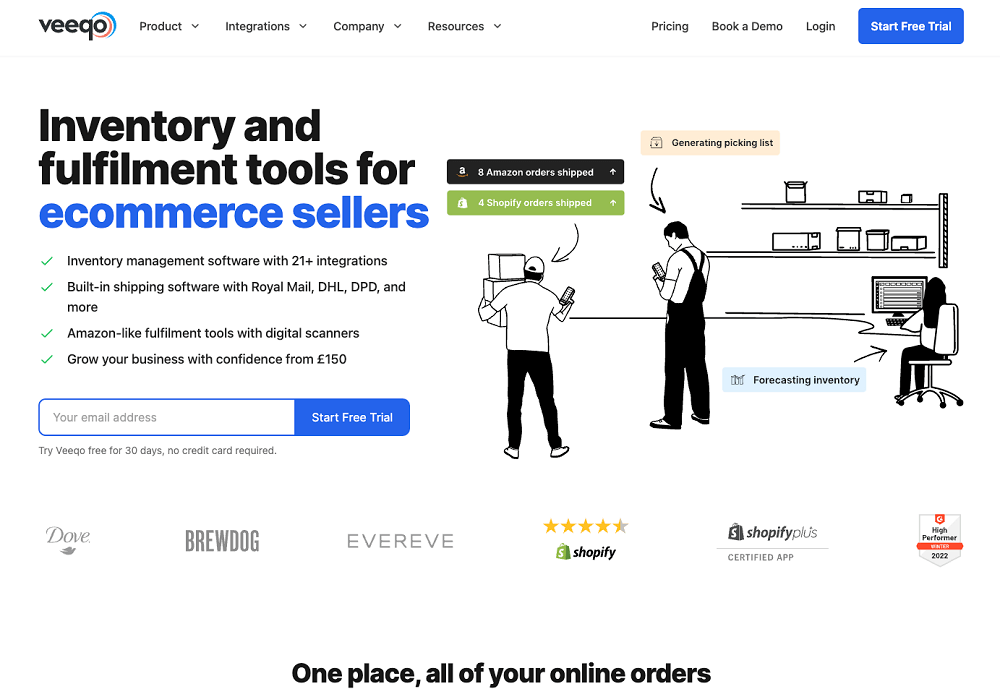
Veeqo is an all-in-one cloud-based software solution that provides inventory and fulfilment tools for eCommerce businesses. Headquartered in the UK, Veeqo offers a solution to streamline your entire logistical process from multiple channels in one location.
The platform offers a seamless integration into the top eCommerce platforms such as Shopify, Amazon, eBay, and Magento - and shows all orders from these channels on the same dashboard. The platform also offers the following features to ensure your fulfilment runs efficiently for your customers:
Inventory management
Order management
Digital picking with scanners
Discounted shipping rates
Order tracking for customers
Shipping software
Reporting and forecasting tools
One of the great things about Veeqo is that the shipping software is built-in with discounted shipping for their partnered brands, including Royal Mail, DPD, UPS, DHL and 20 others.
The platform has processed over £1.3 billion in orders in the past twelve months, with over 28 million orders shipped yearly.
However, it is important to note that Veeqo doesn’t offer a fulfilment centre of its own but provides warehouse management software to streamline your own warehouse. Their prices start from as little as £150 per month, with their premium plans reaching as high as £250.
5. Blue Yonder Warehouse Management
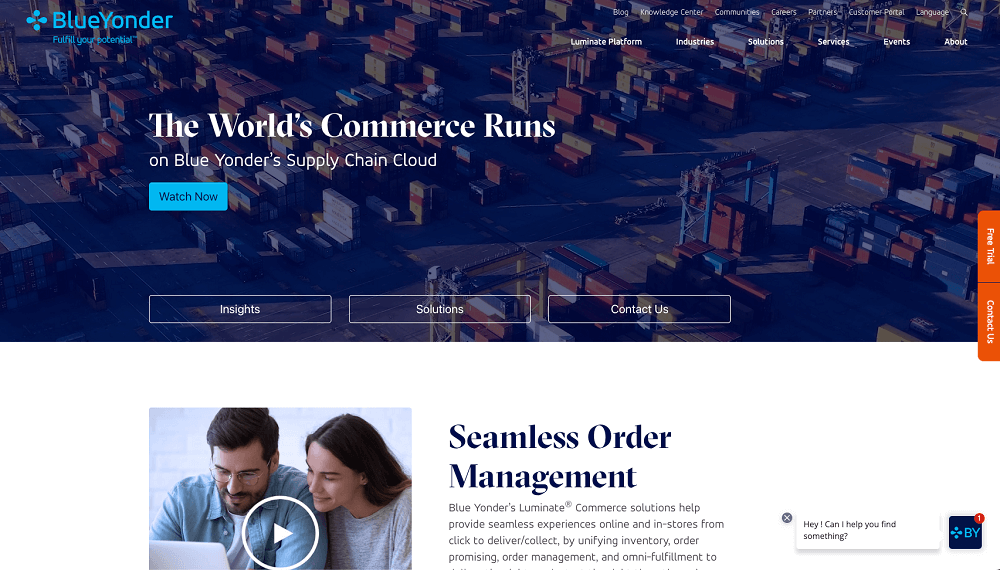
Blue Yonder Warehouse Management, formerly JDA WMS, is a cloud-based WMS that assists businesses with inventory tracking, shipment processing, and data analysis. It also has a particular focus on data visibility, labour utilisation, customer service, and warehouse operations.
The company states that companies achieve a 50% cost reduction, a 15% productivity increase, and 100% improved accuracy by using their warehouse management software.
Over 3000 global organisations are already using the software to power their digital supply chains. Some notable companies include:
7-Eleven
3M
Asda Stores
Avon
BAE Systems Norfolk Ship Repair
Barnes & Noble
Best Buy
BIC
The platform offers real-time inbound and outbound processing, optimised inventory management, unified yard management, and resource orchestration - straight from one dashboard.
One of the great things about Blue Yonder WMS is that it provides end-to-end visibility and uses an AI-driven platform called Luminate, which helps users to synchronise their planning, logistics, and commerce. AI and machine learning help to prevent potential disruptions throughout the entire supply chain before they have the chance to occur.
The platform is easily integrated into the majority of eCommerce platforms, meaning you will be able to connect it to your current operations with minimal effort. It is typically used by medium to large-sized enterprises, but eCommerce brands are also using the software effectively.
To find out the cost of the software, contact the company to request a quote.
6. Oracle Warehouse Management
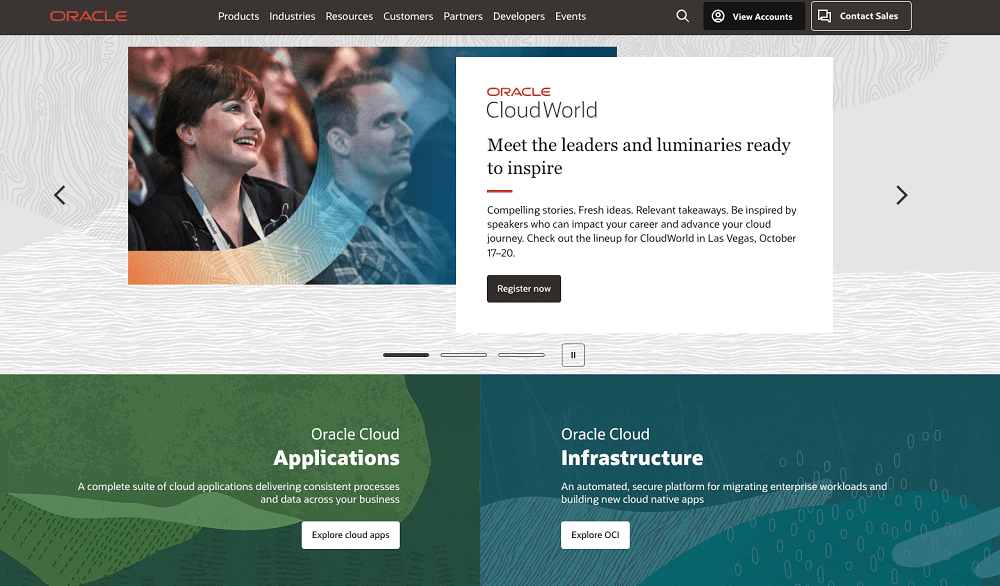
Oracle Warehouse Management is a cloud-based WMS that can cater to enterprise-level organisations. Users of the software can streamline and optimise warehouse capacity, boost productivity, and reduce inventory costs.
Their software can cater to lots of industries, including wholesale distribution, consumer goods, manufacturing, and logistical service providers. However, they are also efficient in the retail and eCommerce sectors.
The WMS can be connected to most eCommerce platforms to fully streamline any eCommerce band into a robust and seamless fulfilment centre. It offers Omni channel fulfilment, the ability to manage returns easily, optimised inventory operations and helps coordinate merchandise movement.
The software is being used by companies such as Toyota, Lyft, Experian, FedEx, Spotify, Bata, DP World, and Second Nature. These companies have used Oracle Warehouse Management to assist with the following:
Improving workforce productivity and reducing labour inefficiency
Supporting new sales channels
Reducing inventory costs
Integrating and automating warehouse operations
The company is based in Austin, Texas, and provides software for various services, including manufacturing, procurement, transportation, product life cycles, and order management.
The company doesn’t offer a free trial, but their Warehouse Management Enterprise Edition starts at $50 a month for 1,000 warehouse transactions.
7. ShipHype Fulfilment
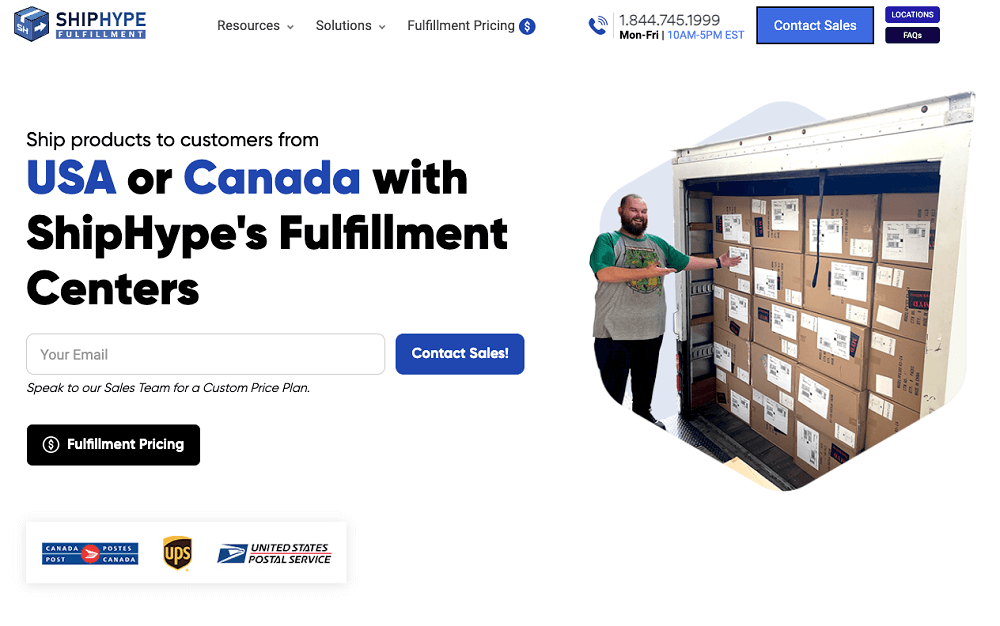
ShipHype is an eCommerce fulfilment ecosystem with fulfilment centres in the USA and Canada. It has five fulfilment centres across North America and has over 200 active clients and DTC brands.
ShipHype can offer next-day delivery for most of its shipments but also offers standard and two-day delivery options. The product can be easily integrated into top eCommerce platforms like Shopify, Amazon, WooCommerce, eBay, and Squarespace.
The entire mission of ShipHype Fulfilment is to help eCommerce brands to scale and compete with enterprise-level retailers. They offer their services with no contracts and can provide discounted shipping rates through their logistical partners.
The cost of using the service is relatively straightforward as it is a pay-as-you-go type service. Pricing for ShipHype can vary depending on your needs, but their lowest package starts at $199 per month.
eCommerce business owners simply have to sign up for the platform and ship their goods to the fulfilment centres. The goods are held in bins or pallets that provide easy-to-gauge pricing. Furthermore, the picking and packing costs are based on the packaging materials used and the number of orders that are shipped per month.
Alongside the eCommerce fulfilment, they also offer the following:
FBA prep services
Subscription box fulfilment
B2B fulfilment
Crowdfunding fulfilment
Their WMS helps eCommerce brand owners to track orders and inventory in real time. They use barcode scanners and RFID to ensure 100% accuracy when shipping products to customers.
8. Fishbowl
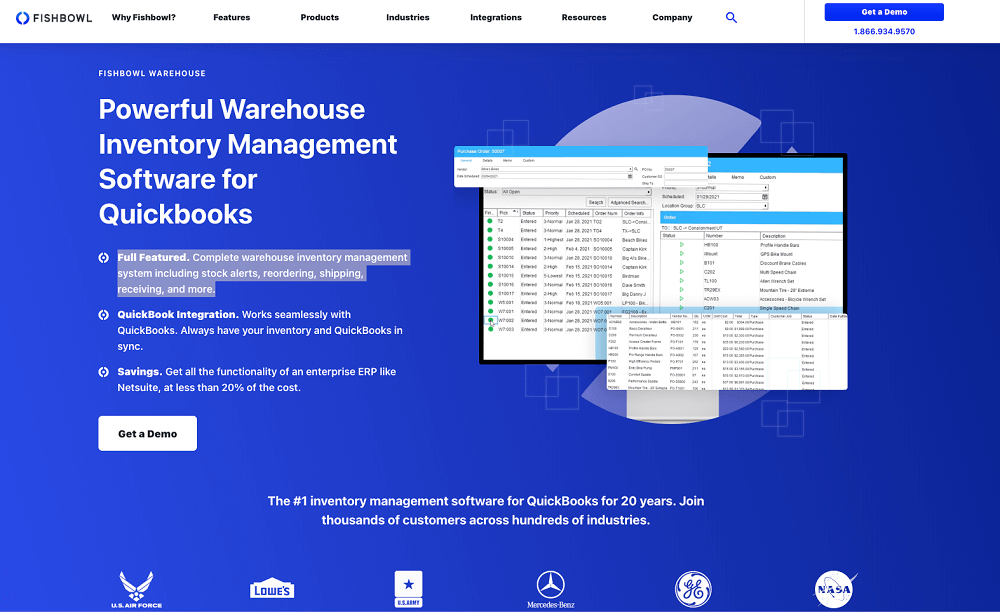
Fishbowl describes itself as the number one manufacturing and warehouse inventory management software for platforms such as QuickBooks, Shopify, and Xero. The software allows eCommerce business owners to automate their inventory management and scale with its powerful inventory control system.
One of their great features is their shipping module which connects you with their shipping partners to help fulfil your orders and track them until they are delivered. But it also has the following additional features:
Inventory management
Barcode scanning
Order management
Serial and lot tracking
Business intelligence
Employee tracking
FishBowl is not cheap and starts at $4,395. However, the warehouse management software offers a free trial to ensure that the software will suit your needs.
Conclusion
If you are serious about growing your eCommerce store into a long-term successfully running business then you need to consider using a professional warehouse facility and integrating a warehouse management system.
The warehouse fulfilment centre will help you store your stock and the warehouse management system itself will help you manage your stock effectively to ensure goods are delivered to your customers as expected.
However, it’s essential to keep in mind that all warehouse fulfilment centres are not created equal, nor are warehouse management systems. Choosing the wrong fulfilment centre today and integrating the wrong management system could potentially lead to costly errors down the line. Therefore, it is essential to weigh up your current and future requirements and pick one of the tested warehouse management systems listed above to increase your chances of long-term success.
Written by

Sam founded his first startup back in 2010 and has since been building startups in the Content Marketing, SEO, eCommerce and SaaS verticals. Sam is a generalist with deep knowledge of lead generation and scaling acquisition and sales.


